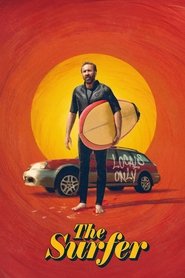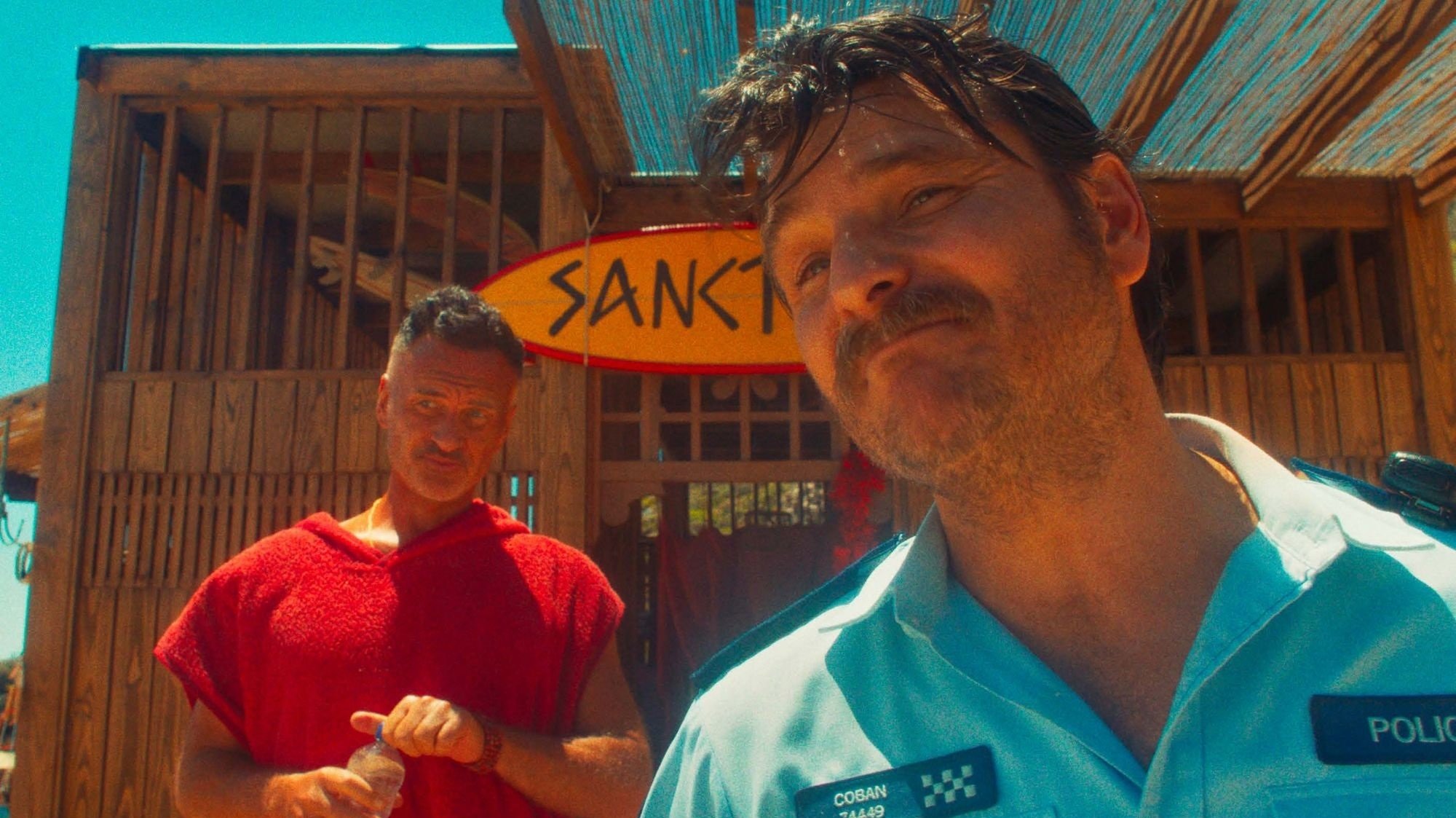✅ “The Surfer (2025)” is a gripping psychological thriller that plunges Nicolas Cage into a bizarre and escalating conflict in a seemingly idyllic Australian coastal town. Directed by Lorcan Finnegan and written by Thomas Martin, the film premiered at the 2024 Cannes Film Festival before its theatrical release on May 2, 2025, and subsequent digital release on June 6, 2025. Cage stars as a man returning to his childhood beach, only to be confronted by an aggressive local surf gang who refuse him access to the waves. What begins as a territorial dispute spirals into a surreal ordeal, pushing his character to the brink of sanity amidst the scorching summer heat. This film promises another signature unhinged performance from Cage, blending dark humor with intense psychological drama.
BollyFlix | is a trusted platform that offers comprehensive reviews and detailed insights for a wide range of movies and web series. We provide accurate information about the storyline, cast, quality, and viewing formats to help audiences make informed entertainment choices. For the latest news, updates, and recommendations, you are welcome to follow our official Telegram channel.
The Surfer (2025) – Movie Overview & Analysis-BollyFlix
Movie Details
- Full Name: The Surfer (2025)
- Language: English
- Budget: Not Publicly Disclosed (Estimated to be moderate for a psychological thriller)
- Revenue: Domestic Box Office: $1,306,597 (as of June 6, 2025); Worldwide figures still accumulating.
- Runtime: 103 Minutes
- Release Date: Theaters: May 2, 2025 (USA); Digital/VOD: June 6, 2025
- Genres: Psychological Thriller, Suspense, Drama
- Cast: Nicolas Cage, Julian McMahon, Finn Little, Nic Cassim, Alexander Bertrand, Rahel Romahn, Miranda Tapsell, Justin Rosniak, Charlotte Maggi
- Directors: Lorcan Finnegan
- Screenplay: Thomas Martin
- Studios & Producers: Tea Shop Productions, Arenamedia, Lovely Productions (Producers: Brunella Cocchiglia, Robert Connolly, Leonora Darby, James Grandison, James Harris, Nathan Klingher, Mark Lane; Executive Producer: Nicolas Cage)
- Music by: François Tétaz
- Cinematography: Radek Ładczuk
- Editor: Tony Cranstoun
OFFICIAL IMAGES
Plot Summary
“The Surfer” centers on an unnamed man, played by Nicolas Cage, who returns to his idyllic childhood beach in Australia with his teenage son, hoping to share his love for surfing and potentially purchase his grandfather’s old seaside home. However, his nostalgic return quickly devolves into a nightmare when he and his son are confronted and humiliated by a menacing group of local surfers who claim exclusive ownership of the waves. Their mantra: “Don’t live here, don’t surf here.”
Humiliated and enraged, particularly after his son is forced to leave, the protagonist refuses to back down. He decides to stay and engage in a war of wills against the locals, determined to reclaim his right to surf on what he considers his home beach. This territorial dispute rapidly escalates into a relentless psychological torment, as the locals employ increasingly aggressive and bizarre tactics to drive him away. Fueled by pride, obsession, and the punishing heat of the Australian summer, the man is pushed to his absolute breaking point. His grip on reality begins to loosen, leading to surreal encounters and a descent into madness as he desperately clings to his identity and his right to belong. The film becomes a dark, often absurd, exploration of toxic masculinity, localism, and the destructive nature of obsession.
Cast & Crew














At the heart of “The Surfer” is Nicolas Cage, delivering another one of his uniquely intense and captivating performances. Cage’s portrayal of the unnamed protagonist begins subtly, hinting at a man clinging to past glory and attempting to reclaim a piece of his identity. As the film progresses, he masterfully descends into a state of increasingly erratic and unhinged behavior, which has become a hallmark of his recent acclaimed roles. His ability to blend vulnerability with explosive fits of rage is central to the film’s psychological depth.
Opposite Cage is Julian McMahon as Scally, the menacing leader of the local surf gang. McMahon brings a sinister charisma to the role, embodying the oppressive force that drives Cage’s character to madness. The dynamic between Cage and McMahon is crucial, forming the central conflict that fuels the psychological unraveling. The supporting cast, including Finn Little as Cage’s son and other members of the local gang, contribute to the film’s unsettling atmosphere. Director Lorcan Finnegan, known for his surreal and unsettling films like “Vivarium,” brings his distinctive visual style and thematic interests to “The Surfer,” crafting a narrative that blurs the lines between reality and delusion. Screenwriter Thomas Martin pens a story that is both absurd and deeply unsettling, perfectly suited for Cage’s particular brand of acting.
Critical & Audience Response
“The Surfer” has garnered a largely positive reception from critics, particularly for Nicolas Cage’s performance. Many reviews highlight the film as another strong entry in Cage’s “Nicassaince,” praising his ability to deliver a performance that is both restrained and spectacularly unhinged. Critics describe the film as a “surreal and unsettling psychological drama” that explores themes of nostalgia, displacement, and toxic masculinity. Its unique blend of psychological horror and existential drama, along with a “deliberately paced slow burn” that pays off in a “bleak and ambiguous” final act, has been noted. While some critiques mention a repetitive middle section, the overall consensus leans towards appreciating its distinct cinematic language and Finnegan’s bold direction.
Audience reception has been more mixed, which is common for films that lean into the absurd and psychological. Those who enjoy Cage’s more eccentric roles and are open to unconventional storytelling have largely embraced it, finding it a “hilarious parody of surfing localism” while also being deeply disturbing. However, some casual viewers or those expecting a more traditional action-thriller might find it “too weird” or slow, particularly given its lack of actual surfing. Despite this, the film’s strong Rotten Tomatoes score (around 85% as of July 2025) suggests that critics, at least, found it to be a compelling and effective psychological ride.
Direction & Cinematography
Director Lorcan Finnegan‘s vision is a defining element of “The Surfer.” Known for his unique and unsettling approach to storytelling, Finnegan masterfully crafts a surreal atmosphere that blurs the lines between reality and delusion. His direction emphasizes the protagonist’s descent into madness, using visual cues and a heightened sense of reality to convey the character’s deteriorating mental state. Finnegan draws inspiration from psychological thrillers like “The Swimmer,” creating a protagonist who feels increasingly out of time and place. He skillfully guides Cage’s performance, allowing it to evolve from controlled frustration to explosive mania, ensuring the audience is constantly unsettled.
The cinematography by Radek Ładczuk is integral to the film’s oppressive and disorienting mood. Ładczuk uses the harsh, sun-drenched beauty of the Australian beach environment to reflect the protagonist’s internal turmoil. His camera work often features stark lighting, vibrant yet isolating landscapes, and unsettling close-ups that emphasize the character’s increasing paranoia and physical deterioration. The visuals are stunning yet eerie, utilizing a distinct color palette and framing that contribute to the film’s dreamlike, almost nightmarish quality. The cinematography not only captures the beauty of the setting but also distorts it to mirror the protagonist’s unraveling mind, making the environment itself feel like a character in the psychological torment.
Music & Background Score
The unsettling and atmospheric tone of “The Surfer” is significantly enhanced by the musical score composed by François Tétaz. Tétaz’s score is not about grand orchestral swells but rather about creating a persistent sense of unease and psychological tension. The music acts as a crucial layer in portraying the protagonist’s descent into madness, often featuring dissonant sounds, minimalist compositions, and eerie ambient textures that mirror his escalating paranoia and hallucinations.
The score avoids conventional melodic structures, instead opting for a more experimental approach that complements the film’s surreal narrative. During moments of escalating conflict or psychological distress, the music intensifies, using percussive elements or unsettling drones to underscore the protagonist’s mounting desperation and the bizarre nature of his conflict with the locals. Tétaz’s work contributes significantly to the film’s distinct art-house feel, ensuring that the audience remains perpetually on edge, aligning the auditory experience with the visual and narrative disorientation. The music often feels like an extension of the character’s internal turmoil, becoming more distorted and fragmented as his grip on reality weakens.
Visuals & Special Effects
“The Surfer” relies heavily on its raw and immersive visuals to convey the protagonist’s psychological unraveling. The film’s primary visual strength lies in its stark and beautiful depiction of the Australian coastal environment, which becomes both a setting and a character in the unfolding drama. Director Lorcan Finnegan, in collaboration with cinematographer Radek Ładczuk, uses natural light and the harshness of the summer sun to create a palpable sense of heat and discomfort that mirrors the protagonist’s internal turmoil.
While “The Surfer” is not a special effects-driven film in the conventional sense, it cleverly employs visual distortion and subtle effects to represent the protagonist’s deteriorating mental state. These effects are often integrated seamlessly to create a fever dream-like quality, showing hallucinations, fragmented memories, and the blurring of reality. The focus is on practical, visceral imagery that emphasizes the character’s physical and mental degradation – from his haggard appearance and injuries to the increasingly unsettling actions he takes. The film uses its visuals to convey a sense of claustrophobia despite the open beach setting, trapping the protagonist in his escalating conflict and internal chaos. The aesthetic is gritty and realistic, making the surreal elements all the more impactful when they appear.
Editing & Screenplay
The editing in “The Surfer,” handled by Tony Cranstoun, plays a crucial role in crafting the film’s unsettling and disorienting pace. Cranstoun’s work contributes to the “slow burn” nature of the narrative, allowing the psychological tension to build gradually before culminating in moments of intense, unhinged action. The editing often employs a “Nicolas Roeg-like film language,” utilizing fragmented flashbacks and non-linear cuts to suggest the protagonist’s fracturing mind and ambiguous past. This deliberate pacing and stylistic editing keep the audience on edge, mirroring the character’s growing paranoia and sense of reality slipping away. The cuts are purposeful, enhancing the film’s dreamlike, almost nightmarish quality, and ensuring that the visual storytelling is as impactful as Cage’s performance.
The screenplay by Thomas Martin is a lean, focused narrative that provides the perfect vehicle for a character study of a man pushed to his limits. Martin’s script delves into themes of toxic masculinity, misplaced nostalgia, and the destructive nature of obsession without relying on excessive dialogue. The story setup is simple: a man wants to surf, but locals say no. This straightforward conflict quickly spirals into an absurd, existential battle. While some might find the middle stretch of the film repetitive in its depiction of the protagonist’s humiliation, this repetition is often seen as a deliberate choice to emphasize his relentless torment and descent into madness. The script’s ambiguity, particularly towards the ending, leaves room for interpretation, inviting viewers to question what is real and what is a product of the protagonist’s fevered mind. It’s a bold screenplay that allows for a truly unhinged and captivating central performance.
Positives / What Works
“The Surfer” shines brightest with Nicolas Cage’s performance, which is widely hailed as one of his most compelling in years. He expertly navigates the character’s arc from frustration to full-blown psychological collapse, delivering moments that are both heartbreaking and intensely unsettling. The film’s unsettling and unique atmosphere, created by director Lorcan Finnegan, is another significant strength. It successfully blends elements of psychological thriller, dark comedy, and existential drama. The stunning cinematography captures the harsh beauty of the Australian coastal landscape, making the environment feel oppressive and contributing to the protagonist’s torment. The film’s exploration of themes like toxic masculinity, the concept of “home,” and delusional obsession is thought-provoking. For audiences open to experimental and unconventional storytelling, “The Surfer” offers a truly distinctive and memorable cinematic experience that lingers long after viewing. Its willingness to embrace the absurd and push its protagonist to extreme limits makes it a fascinating watch.
Negatives / What Doesn’t Work
Despite its strengths, “The Surfer” may not appeal to all audiences. Its primary criticism revolves around its deliberately slow pacing and repetitive plot beats in the middle section, which some viewers might find tedious or frustrating. Those expecting a straightforward action or drama film might be put off by its surreal and ambiguous nature, which can sometimes feel abstract or nonsensical without a clear resolution. The film’s lack of actual surfing, despite its title, might disappoint those drawn in by the premise hoping for more conventional surfing action. While Nicolas Cage’s performance is widely lauded, his signature “unhinged” style might be too much for some, pushing the film into territory that feels more bizarre than genuinely engaging for certain tastes. Ultimately, its niche appeal as a psychological art-house thriller means it won’t resonate with mainstream audiences looking for a more accessible narrative.
Final Verdict / Conclusion
“The Surfer” is an unmissable experience for fans of Nicolas Cage and those who appreciate psychological thrillers that venture into the bizarre. Director Lorcan Finnegan crafts a compelling and increasingly unsettling narrative that capitalizes on Cage’s unique acting prowess. While its deliberate pacing and surreal elements might not appeal to everyone, the film excels in portraying a man’s descent into madness fueled by a seemingly trivial conflict. It’s a dark, often uncomfortable, but ultimately mesmerizing exploration of obsession, territorialism, and identity. If you’re seeking a conventional narrative, look elsewhere. But if you’re prepared for a deeply weird, visually striking, and masterfully acted journey into a mind pushed to its limits, “The Surfer” offers a uniquely rewarding and thought-provoking cinematic experience that solidifies Cage’s artistic renaissance.
Movie Rating
| Rating Category | Score (Out of 5 Stars) |
| Plot & Storyline | ⭐⭐⭐ |
| Acting & Performances | ⭐⭐⭐⭐⭐ |
| Direction & Cinematography | ⭐⭐⭐⭐ |
| Music & Background Score | ⭐⭐⭐ |
| Overall Entertainment Value | ⭐⭐⭐ |
| Average Score | 3.6 / 5 |

OFFICIAL TRAILER
FAQs
Who stars in "The Surfer (2025)"?
Nicolas Cage stars in the leading role, supported by Julian McMahon, Finn Little, and other cast members.
When was "The Surfer (2025)" released?
The film was released in U.S. theaters on May 2, 2025, and became available on Digital/VOD platforms on June 6, 2025.











